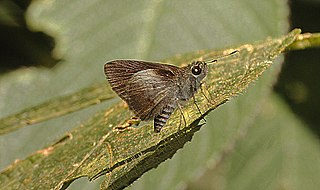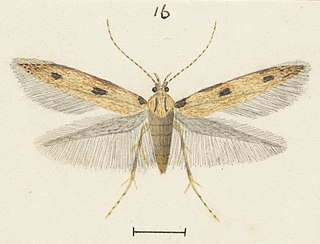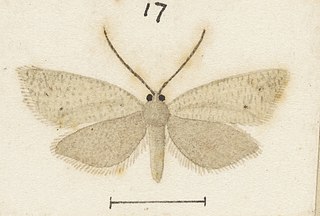
Suastus gremius, the Indian palm bob or palm bob, is a butterfly belonging to the family Hesperiidae. It is found in the Indomalayan realm.

Suastus minuta, the small palm bob, is a butterfly belonging to the family Hesperiidae. It is found in the Indomalayan realm - south India, Sikkim to Burma, Sri Lanka, Thailand, Laos, Hainan, Vietnam and Malaya.

Zealandopterix zonodoxa is a moth of the family Micropterigidae. It endemic to New Zealand and is found from the Hawkes Bay north as well as on Poor Knights, Little Barrier and Great Barrier Islands. It is the smallest micropterigid in New Zealand and the shiny white markings on the forewing of this species are variable. It is a day flying moth, but has been collected using UV light. Adults are on the wing from September to March and the species has been witnessed visiting the flowers of Nikau and Cordyline pumilio in large numbers. It inhabits a wide variety of moist indigenous forest but is associated with forests in which podocarps are common. Larvae have been sieved from rotten wood on the floor of a mixed podocarp/broadleaf forest or extracted from moss or from bryophytes.

Pyroderces aellotricha, also known as the Cosmet moth, is a moth of the family Cosmopterigidae. It is found in New Zealand, in Australia and the Cook Islands.

Elachista gerasmia is a species of moth of the family Elachistidae that is found in New Zealand and south eastern Australia.

Eusthenica treicleiota is a species of moth in the family Cossidae and the only species in the genus Eusthenica. It was described by George Thomas Bethune-Baker in 1911. It is found in Australia, where it has been recorded from Queensland.

Labdia anarithma is a moth of the family Cosmopterigidae. It was described by Edward Meyrick in 1888. It is found in New Zealand and throughout Australia. Adults are on the wing from December to March and are day flying. They have been collected by sweeping bracken fern.
Carposina petraea is a moth in the family Carposinidae. It was described by Edward Meyrick in 1910. It is found in Australia, where it has been recorded from South Australia and Victoria.
Copromorpha phaeosticta is a moth in the Copromorphidae family. It is found in Australia, where it has been recorded from Queensland.
Napecoetes belogramma is a moth in the Psychidae family. It was described by Turner in 1916. It is found in Australia, where it has been recorded from Queensland.
Leptozestis oxyptera is a moth in the family Cosmopterigidae described by Oswald Bertram Lower in 1900. It is found in Australia, where it has been recorded from New South Wales.

Ericodesma aerodana is a species of moth of the family Tortricidae. It is endemic to New Zealand and is found in the North and South Islands. The species inhabits sand dunes and larvae feed on Pimelea prostrata. Adults are on the wing from October to January and are active at twilight. This species is classified as "At Risk, Declining" by the Department of Conservation as its larval host plant is under threat from habitat loss and the invasive to New Zealand plant, sea spurge.
Machimia miltosparsa is a moth in the family Depressariidae. It was described by Turner in 1914. It is found in Australia, where it has been recorded from New South Wales.
Garrha cholodella is a moth in the family Oecophoridae. It was described by Edward Meyrick in 1883. It is found in Australia, where it has been recorded from New South Wales.
Garrha costimacula is a moth in the family Oecophoridae. It was described by Edward Meyrick in 1883. It is found in Australia, where it has been recorded from Queensland and New South Wales.
Garrha rufa is a moth in the family Oecophoridae. It was described by Edward Meyrick in 1883. It is found in Australia, where it has been recorded from New South Wales.
Garrha metriopis is a moth in the family Oecophoridae. It was described by Edward Meyrick in 1887. It is found in Australia, where it has been recorded from New South Wales.

Eochrois sarcoxantha is a moth in the family Oecophoridae described by Oswald Bertram Lower in 1893. It is found in Australia, where it has been recorded from New South Wales and Victoria.
Dichomeris melichrous is a moth in the family Gelechiidae. It was described by Edward Meyrick in 1904. It is found in Australia, where it has been recorded from New South Wales.
Tanycnema is a monotypic moth genus of the family Tineodidae or false plume moths. It was described by Alfred Jefferis Turner in 1922. Turner described the genus in Proceedings of the Royal Society of Victoria, writing:
Gen. Tanycnema, nov.
Frons with a strong anterior tuft of hairs. Tongue present. Palpi rather long, porrect. Maxillary palpi obsolete. Antennae short. Legs long, slender; outer tibial spurs about 3/4 length of inner spurs. Forewings narrow, elongate; 2 from well before angle, 3 from angle, 4 and 5 somewhat approximate at origin, 6 from upper angle, 7, 8, 9, 10 stalked, 7 arising slightly before 10, 11 free. Hindwings twice as broad as forewings; 2 from 3/4, 3 from angle, 4 and 5 somewhat approximate at origin, 6 well separated at origin from 5, still more widely from 7, 7 from upper angle, closely approximated to 12 for some distance, but not anastomosing.
A peculiar, isolated, and primitive genus. The wide separation of 6 from 7 of the hindwings, and the absence of any anastomosis of 7 with 12 are primitive characters; on the other hand the relative approximation of 5 to 4 in the hindwings, and the stalking of 7 and 10 of the forewings are specialised characters, the former being unique in this family, to which the genus must, I think, be referred, though the absence of maxillary palpi, suggests some relationship to the Pterophoridae, but this may be more apparent than real.








